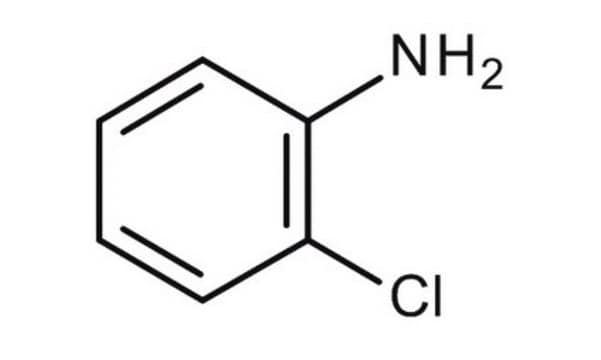23300
2-Chloroaniline
≥99.5% (GC)
About This Item
Prodotti consigliati
Saggio
≥99.5% (GC)
Forma fisica
liquid
Indice di rifrazione
n20/D 1.589
P. eboll.
208-210 °C (lit.)
Punto di fusione
0-3 °C
Solubilità
water: soluble 5.13 g/L at 20 °C
Densità
1.213 g/mL at 25 °C (lit.)
Stringa SMILE
Nc1ccccc1Cl
InChI
1S/C6H6ClN/c7-5-3-1-2-4-6(5)8/h1-4H,8H2
AKCRQHGQIJBRMN-UHFFFAOYSA-N
Cerchi prodotti simili? Visita Guida al confronto tra prodotti
Categorie correlate
Descrizione generale
Avvertenze
Danger
Indicazioni di pericolo
Classi di pericolo
Acute Tox. 3 Dermal - Acute Tox. 3 Inhalation - Acute Tox. 3 Oral - Aquatic Acute 1 - Aquatic Chronic 1 - Eye Irrit. 2 - Muta. 2 - STOT RE 2
Codice della classe di stoccaggio
6.1A - Combustible acute toxic Cat. 1 and 2 / very toxic hazardous materials
Classe di pericolosità dell'acqua (WGK)
WGK 3
Punto d’infiammabilità (°F)
221.0 °F - closed cup
Punto d’infiammabilità (°C)
105 °C - closed cup
Dispositivi di protezione individuale
Eyeshields, Faceshields, Gloves, type ABEK (EN14387) respirator filter
Certificati d'analisi (COA)
Cerca il Certificati d'analisi (COA) digitando il numero di lotto/batch corrispondente. I numeri di lotto o di batch sono stampati sull'etichetta dei prodotti dopo la parola ‘Lotto’ o ‘Batch’.
Possiedi già questo prodotto?
I documenti relativi ai prodotti acquistati recentemente sono disponibili nell’Archivio dei documenti.
I clienti hanno visto anche
Il team dei nostri ricercatori vanta grande esperienza in tutte le aree della ricerca quali Life Science, scienza dei materiali, sintesi chimica, cromatografia, discipline analitiche, ecc..
Contatta l'Assistenza Tecnica.

















